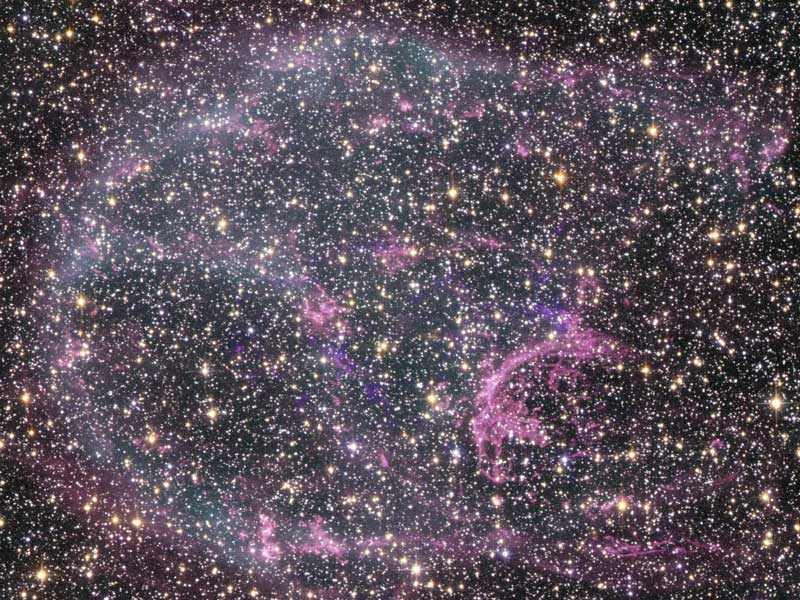Credit & Copyright: NASA,
ESA, and
The Hubble Heritage Team
(STScI/AURA)
Acknowledgment: J.C. Green (Univ. of Colorado) and the Cosmic Origins Spectrograph (COS) GTO team; NASA/CXO/SAO
Explanation:
Thousands of years after a star exploded, its expanding remnant
still glows brightly across the spectrum.
Such is the case with
N132D, a
supernova remnant located in the neighboring
Large Magellanic Cloud (LMC) galaxy.
The expanding shell from this explosion now spans 80
light-years
and has swept up about 600 Suns worth of mass.
N132D was imaged recently in optical light and in great detail with the
Hubble Space Telescope.
The Hubble image was then combined with a position coincident detailed image in
X-ray light taken by the
Chandra X-ray Observatory.
The combination,
shown above
in representative colors, shows a nearly spherical expanding
shockwave
highlighted by pink emission from
hydrogen
gas and purple emission from
oxygen gas.
A dense field of unrelated stars also from the
LMC populates the image.
Studying the image gives an opportunity to study material
once hidden deep inside a star.
N132D spans about 150 light years and lies about 160,000
light years away toward the
constellation of
Dorado.
Acknowledgment: J.C. Green (Univ. of Colorado) and the Cosmic Origins Spectrograph (COS) GTO team; NASA/CXO/SAO
1999 2000 2001 2002 2003 2004 2005 2006 2007 2008 2009 2010 2011 2012 2013 2014 2015 2016 2017 2018 2019 2020 2021 2022 2023 2024 2025 |
Январь Февраль Март Апрель Май Июнь Июль Август Сентябрь Октябрь Ноябрь Декабрь |
NASA Web Site Statements, Warnings, and Disclaimers
NASA Official: Jay Norris. Specific rights apply.
A service of: LHEA at NASA / GSFC
& Michigan Tech. U.
|
Публикации с ключевыми словами:
n132d - supernova remnant - остаток Сверхновой - рентгеновское излучение
Публикации со словами: n132d - supernova remnant - остаток Сверхновой - рентгеновское излучение | |
См. также:
Все публикации на ту же тему >> | |
